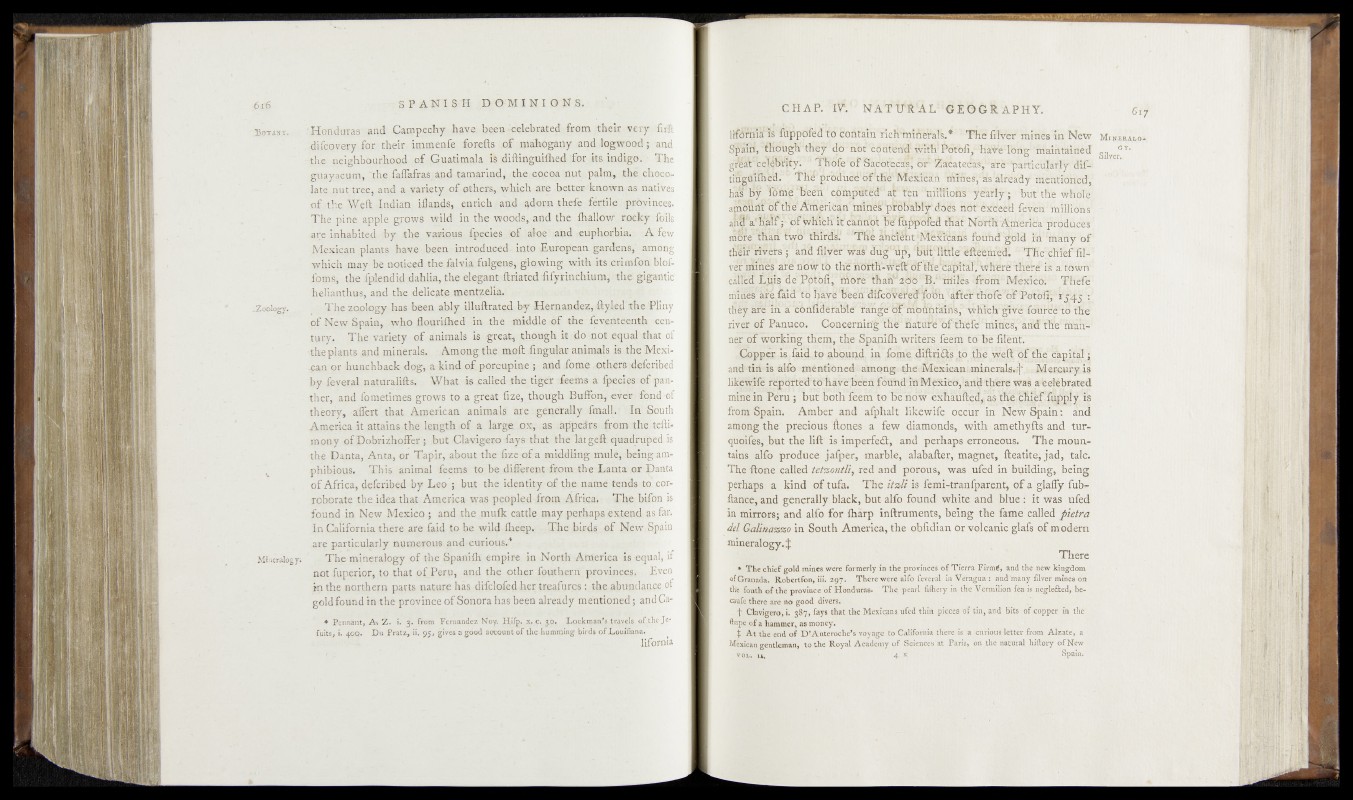
:Honduras' and Campechy have been-celebrated from their very; firit
'.difdeyery for their immenfe forefts ,of mahogany and logwood; and
7|b;e neighbourhood of Gmatimala is diftinguilhed for its indigo. The
guayacum, 'the faffafras.and tamarind, the cocoa nut palm, the. chocolate
nut tree, and a variety of others, which are better known as natives
o f tire Weft Indian Hands, enrich and ^dorn thefe fertile provinces.
The pine apple grows wild in the woods, and the fhallow rocky foils
.are inhabited by the various fpecies of aloe and euphorbia. A few
Mexican plants have been introduced- into European gardens, among
•which may be noticed the falvia fulgens, glowing with its crimfon blof-
foms, the fplendid dahlia, the elegant -ftriated fifynncbium, the. gigantic'
helianthus, and the delicate mentzelia.
'1 he zoology has been ably illuftrated by Hernandez, ftyled the Pliny
of New Spain, who llourifired [in the middle of the feventeenth century."
The variety of animals I s great, though it do-not equal that of
•the plants ;.and minerals, t Among the moft Angular animals. is the Mexican
or hunchback-dbg, a kind of porcupine ; and fome , others -deferibed
by feveral natufalifts. What is called the tiger Teems a fpecies of panther,
and fometimes grows to a great fize, though Buffon, ever fond of
theory-, afiert that American animals arc generally fmall. In South
.America it attains the length of a large, ox., as appears from the tclli-
mony of Dobrizh.offer; but Clavigero fays that the large ft quadruped is
the Danta, Anta, or Tapir, about the fize of a middling mule, being amphibious.
This animal feems to be different from the Lanta or Danta
of Africa, deferibed by Leo ; but the identity of the name tends to corroborate
the idea that America was peopled from Africa. The bifon is
found in New Mexico ; and the mulk cattle, may perhaps extend as. far.
In .California there are faid to be wild- flicep. The birds of New Spain
.are particularly numerous and curiou.s/
The mineralogy of the Spanifli empire in .North America is equal, if
not fuperior, to that o f Peru, and the other foutherri provinces. Even
in the northern parts nature has difeiofed her treafures : the ahundance of
gold found in -the province of Sonora has been already mentioned; and Ca-
♦ Pennant, A-. Z. i. 3. from Fernandez Noy. Jfifj). x. c, 30. Lockman’s travels of .the Jc-
fuits, i. 400. Du Pratz, ii.95, gives a good account-of the -humming birds of Louifiana.
.-. difornia
lffoi nifl is fuppoféd to contain i ichffninerall. * The fiivèr mines in New
Spain1, though they dd - not' eontend’' with- Potófi, • havëTong maintained
grfeatxelbbn'ty. Thöfe of Sacotecas; H i1 èaéate'das, a r e v .iib dif-:
tmguilhed. Thë'gröducè'oFhbhM'eSicah mines,' as”already mentioned,
has ’lay fome .‘been 1 cómpntèid'' at fen • 'millions yearly; but the whole
amount o f the American1 minés’iifdbabiy doés not: exceell (even millions
a raV naif; ■ o f which it cannot he' fü^pöfed that' Noith'ASn'ërtba produces 1
i^e-rnan“ Wo* mirasV feSfeamfS
fKir livers y *riTffe3dffilPfiT-:
ver uiines afe'nbvytt) the hörüt-Wëftf o f flïefcapSbff,' where theréTs a town
called Luis de Potoli/ more thaftWöo 13.’ miles from Mexico. Thefe
miiies; are faid to
they Itfl m a confiderahlh Tah^*^ffimOTi®bs3w t t f i<^^T(3iffcl^ro ftd
rivet of Panuco. ConcernirfgTnh*nature
n^of working, thermthc Spanifh wfitêps'Teem taTeTiTëïïtT
rjQ(ppp^,dat%d- tp abpiipd Wioa>Ev4^bflgj|d
an#tlri is piéntiönedi amptig. ^étMexicanuainei^fl^TKMëSfinryis
likeMfi f Hpdf MéXifcy^artdttóf ë was ahdhèbtfated
ntine in Peru; bgt both leem to be now" exhaunq^ a^ tne^Rmf^ummyris
from .Spain. Amber and. afphalt likewife occur in NW Spain: and
among, the precious 'fton.es a few diamonds, with amethyfts and tur-
qupifes,' but the lift fs imperfedt, and perhaps erroneous. The mountains
alfo produce jafper, marble, alabafter, magnet, fteatite; jad, talc.
The ftone called tetzontli, red and porous, was ufed in byilding, being
perhaps a kind of tufa. The itzti is femi-tranfparent, of a glafiy fubjf
ftance^and generally black, but alfo found white and bluef.it véas ufed
in mirrors; and alfo for {harp inftruments, being the fame" called pietra
del Galinazzo in South America, the obfidian pr volcanic glafs of modern
mineralogy. $
There
» The chief gold mines were formerly in the provinces of Tierra Firmë, and the new kingdom
of Granada. Robertlon, iii. 297. There were alfo feveral in Veragua: and'many filver mines "on
m fouth of the province of Honduras. The pearl fithery in the Vermilion tea is ncgle&ed, because
there are no good divers.
t Clavigero, i. 387, fays that the Mexicans ufed thin pieces of tin, and bits of copper in the ■
Aiape of a hammer, as money.
j At the end of D’-Auteroche’s voyage to California there is a curious letter from Abate, a •
Mexican gentleman, to the Royal Academy of Sciences at Paris, on the natural hiftóry oftfew
W%, ii] 4 x ' ', Spain.
MlNSRAtO*.
gy.: m
Silver.,